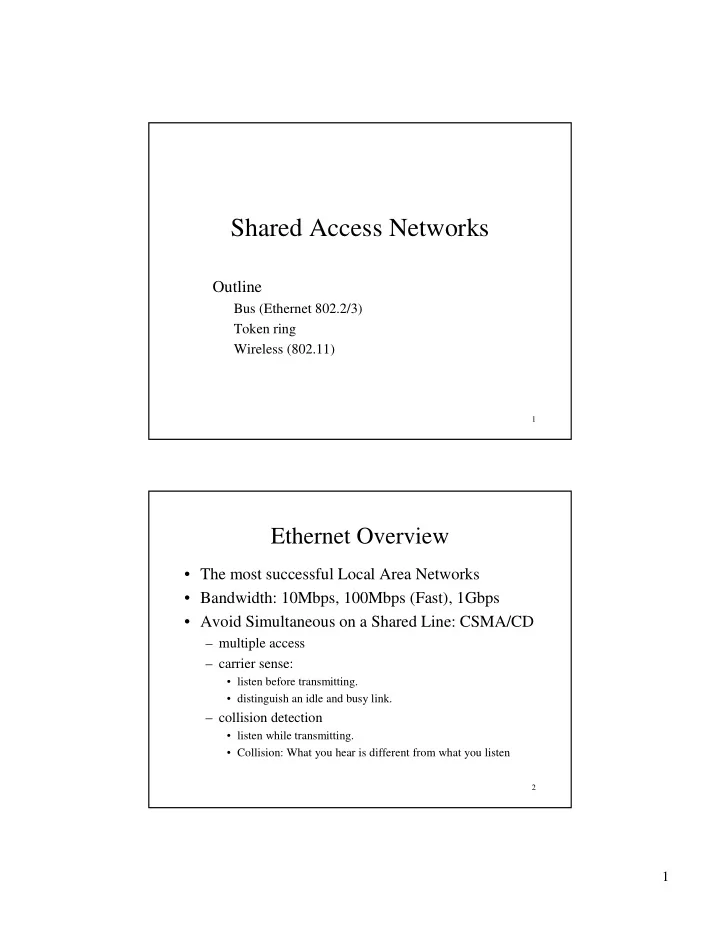

Shared Access Networks Outline Bus (Ethernet 802.2/3) Token ring Wireless (802.11) 1 Ethernet Overview • The most successful Local Area Networks • Bandwidth: 10Mbps, 100Mbps (Fast), 1Gbps • Avoid Simultaneous on a Shared Line: CSMA/CD – multiple access – carrier sense: • listen before transmitting. • distinguish an idle and busy link. – collision detection • listen while transmitting. • Collision: What you hear is different from what you listen 2 1
Ethernet Frame 64 48 48 16 32 • Frame Format Dest Src Preamble Type Body CRC addr addr • Addresses – unique, 48-bit unicast address assigned to each adapter • example: 8:0:e4:b1:2 – Every body hears the frame (shared media). But the one with matching destination address picks up. – broadcast: all 1 s – multicast: first bit is 1. The host can configure its adaptor to accept some multicast addresses • Preamble (a seq. alternating 0s and 1s ) indicates the start of a frame • Type: high-level protocols 3 Ethernet Repeater • Repeaters – Amplifier forwarding signals – Segments separated by repeqters are in the same collision domain • Max Length: 2500m – A coaxial copper cable of up to 500m – segments with 4 repeaters – max round-trip delay: 51.2us Hub Hub 4 2
Transmit Algorithm • If line is idle… – send immediately – upper bound message size of 1500 bytes • Limited occupancy on the line. – must wait 9.6us between back-to-back frames • To allow other hosts to send. • If line is busy… – wait until idle and transmit immediately 5 Collisions A B • The remote side may send (a) its frame before it hears the frame currently being sent A B – Both sides detect an idle line (b) – Due to the propagation delay A B • For A to detect the collision (c) – Collisions can only be A B detected during transmission – 51.2us •10Mbps = 64 bytes (d) 6 3
Upon Collision • Send 32 jam bits, then stop transmitting frame – To ensure other hosts to detect conllision • minimum frame is 64 bytes (header + 46 bytes of data) • delay and try again: exponential backoff – 1st time: 0 or 51.2us selected at random – 2nd time: 0, 51.2, or 102.4us – nth time: k x 51.2us, for randomly selected k =0..2 n - 1 – give up after several tries (usually 16) 7 Token Ring • Idea – Frames flow in one direction: upstream to downstream – special bit pattern (token) rotates around ring – must capture token before transmitting – release token after done transmitting – remove your frame when it comes back around – stations get round-robin service • Lost Token – no token when initializing ring – bit error corrupts token pattern – node holding token crashes • Generating a Token 8 4
Wireless LANs • IEEE 802.11 • Bandwidth: 1 - 11 Mbps • Physical Media – diffused infrared (10m) • Diffused: the sender do not need a clear line of sight. – spread spectrum radio (2.4GHz): 11 Mbps ⇒ 54Mbps 9 Spread Spectrum • Idea – spread signal over wider frequency band than required – Minimize the impact of interference between different LANs – originally designed to thwart jamming • Approach I: Frequency Hopping – transmit over random sequence of frequencies – sender and receiver share pseudorandom number generator and seed – 802.11 uses 79 x 1MHz-wide frequency bands 10 5
Spread Spectrum (cont) • Approach II: Direct Sequence – for each bit, send XOR of that bit and n random bits – The receiver counts the number of 1s in each symbol – random sequence known to both sender and receiver – 802.11 defines an 11-bit chipping code • Requires a frequency band n times wider • The signal looks like noise to any receiver with different pseudorandom sequence Data stream: 1010 Random sequence: 0100101101011001 11 XOR of the two: 1011101110101001 Collisions Avoidance • Similar to Ethernet: Wait until link idle • Problem: hidden and exposed nodes – A ⇒ C; C ⇒ B; • Collides at B • A, C cannot detect: hidden nodes – B ⇒ A; C ⇒ D; A B C D • C assumes collision • Actually no collision at A or D • Cannot (listen) detect collision when transmit 12 6
Multiple Access with Collision Avoidance (MACA) • Sender transmits RequestToSend (RTS) frame – Specifying how long to hold the medium • Receiver replies with ClearToSend (CTS) frame • Neighbors… – see CTS: keep quiet – see RTS but not CTS: receiver cannot hear me, ok to transmit • Receive sends ACK when has frame – neighbors silent until see ACK • Collisions – no collisions detection – known when don’t receive CTS or ACK • The cost of collision with RTS/CTS is much smaller – exponential backoff 13 Supporting Mobility • Case 1: ad hoc networking • Case 2: access points (AP) – Tethered – each mobile node associates with an AP (base station) – Mobile nodes sends to AP first; AP forwards Distribution system AP-1 AP-3 F AP-2 A B G H C E D 14 7
Mobility (cont) • Scanning (selecting an AP) – node sends Probe frame – all AP’s w/in reach reply with ProbeResponse frame – node selects one AP; sends it AssociateRequest frame – AP replies with AssociationResponse frame • When – active: when join or move • Signal with old AP weakened • new AP informs old AP via tethered network – passive: AP periodically sends Beacon frame 15 8
Recommend
More recommend